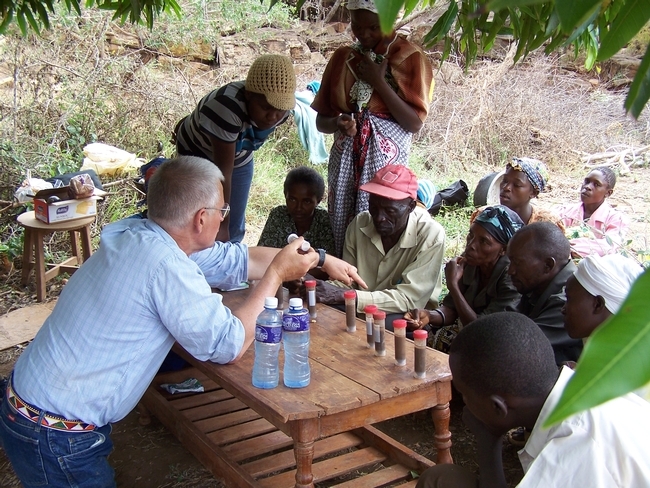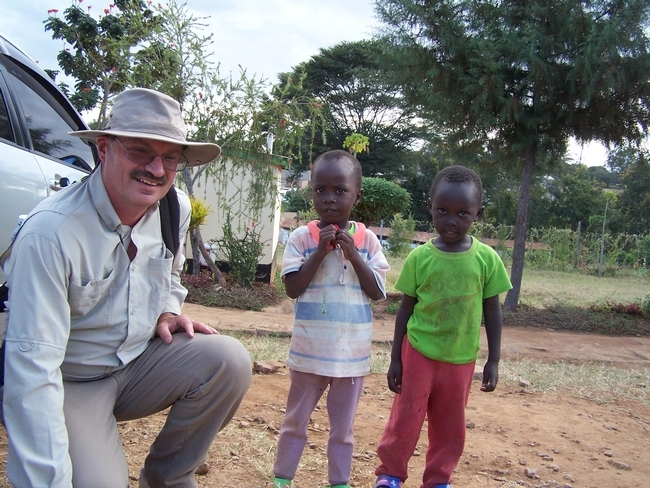Posts Tagged: Oleg Daugovish
UC researchers share knowledge in Kenya’s Kitui District
In June of this year, three University of California scientists went to the Kitui District of Kenya on a USAID mission.
Food and water scarcity are simply a part of life for most in this region. Since 1992 the Sahelian Solution Foundation (SASOL) has been constructing dams and working with Kitui communities to address water scarcity and issues of community development and agricultural production.
Agricultural production in Kenya is full of challenges. Water is carried by hand from wells or dams for household and agricultural needs. Previous to this mission, crops were watered inefficiently by flooding small basins. Nitrogen tests in some locations revealed levels at which most vegetable crops would be nitrogen deficient. Some of the villages have no road access.
UC’s Steve Fennimore, Jeff Mitchell, and Oleg Daugovish went to help SASOL and the people they serve make better use of their resources.
They met with village leaders and SASOL personnel in Kitui. Here they provided training and demonstrations covering topics including:
- Demonstrations of gravity-flow drip irrigation systems from water tanks to individual beds with irrigation lines
- Discussed use of mulches on soil to minimize evaporation and enhance soil conservation
- Solarization, nursery for transplants, diseases and insects, training tomato plants and culture
- Soil types, determination of soil moisture, quick nitrogen test, use of cover crops and mulches
- Water quality (pH, hardness, salts), organic fertilizers, collection and use of urine as a rapidly available nitrogen source.
Later the information was shared in the Maito village, where onions, green kale and green grams (Phasleolus aureus) are grown. The next day found the group in the Kituvwi village, where due to poor crop production, meals are currently limited to once a day. The following day was spent in the Kathayoni village. Farmers in the Kathayoni village grow kale, onions and tomatoes.
SASOL will continue the training for members in villages not reached during this visit.
The majority of farmers in the Kitui District are women. Information was well received in all locations and many questions were asked. At each village the scientists were fed a stew of corn and beans, supplemented by avocado slices or bread, with tea and milk to drink.
The last day time was spent at the South East University College. Potential for agricultural experimentation and greenhouses was discussed, and UC scientists gave a seminar about UCCE function and on anaerobic soil-borne pest control.
Alternatives to fumigation and improving fumigant efficacy
Synthetic soil fumigants such as chloropicrin and 1,3-D are used by some commercial growers to control soilborne pathogens, weeds and nematodes prior to planting strawberries, onions, tomatoes, eggplant, peppers and spinach.
These fumigants and all other biocidal products with the potential to harm the environment and human health are highly regulated by the federal Environmental Protection Agency, the state Department of Pesticide Regulation, and county agricultural commissioner's offices.
UC Cooperative Extension farm advisor Oleg Daugovish and his collaborators work hard to find effective, environmentally safe and economically viable ways to improve efficacy of fumigants and to investigate alternatives to soil fumigation. The Ventura County Cooperative Extension website has archived audio and visual presentations, which include the following topics:
- Assessment of permeability of commercial tarps under a variety of cultural practices and in various soil and environmental conditions is expected to lead to better understanding of maximizing fumigant effectiveness while reducing emissions.
- Growing in substrate (soil-less culture) allows growers to produce crops with minimal plant disease and weeds without using fumigants.
- Heating soil using steam is a successful way to disinfest it. However, the process to generate steam in a field can be slow and very expensive. Researchers are working to find ways to improve speed while reducing cost.
- Most organisms, including plant pathogens, cannot survive without oxygen. Researchers are investigating an organic method to create anaerobic (oxygen-free) conditions to treat soil before planting.
- Planting mustard as a cover crop can provide many positive benefits, one of which is allelochemical compounds. These compounds found in mustard are similar to those found in fumigants. Current research shows it is possible to use this green biomass to prepare fields for production.
To read more about Daugovish's research, visit http://ceventura.ucdavis.edu/Com_Ag/comveg.




